You’ll need to secure municipal permits through your city or county office, ensuring your fire pit meets minimum 36-inch diameter requirements using non-combustible materials like stone or metal. Obtain homeowners association approval with detailed design plans, maintain proper setback distances from property lines, and keep safety equipment like fire extinguishers nearby. You must comply with fuel restrictions allowing only clean firewood, monitor burn bans regularly, notify your insurance company, and follow wind speed limitations. Understanding these essential requirements will help you navigate the complete approval process successfully.
Understanding Municipal Fire Pit Permit Applications

Before installing a fire pit in your backyard, you’ll need to navigate the municipal permit application process to guarantee your project meets local safety standards.
Municipal permits ensure your backyard fire pit installation complies with local safety regulations before you begin construction.
You can obtain applications through your city or county government websites or offices. Fire pit laws require contained structures within approved designs to prevent uncontrolled fires from spreading.
You must also check local ordinances for specific requirements and current burn bans that could affect your permit status.
Don’t forget to verify homeowners association rules, as they often impose additional restrictions beyond municipal regulations. These HOA requirements must be followed alongside city permits.
Regularly monitor updates to local ordinances and burn ban announcements to maintain ongoing compliance with your fire pit permit requirements throughout the year.
Setback Distance Requirements From Property Lines
Two critical distance requirements govern where you can legally place your fire pit: maintaining at least 10 feet from property lines and positioning it 25 feet away from any combustible materials like structures, trees, or shrubs.
These setback distance requirements aren’t just suggestions—they’re legally mandated safety measures that protect your property and neighbors from fire hazards.
Before installation, you’ll need to verify local zoning laws specific to your area, as some neighborhoods impose stricter regulations than Houston’s standard requirements.
Your homeowner’s association might enforce additional restrictions that exceed city ordinances, making fire pits legal placement even more challenging.
Carefully measure and document these distances during your planning phase.
Non-compliance can result in costly violations, forced removal, and potential liability issues if accidents occur.
Fire Pit Size and Construction Material Specifications
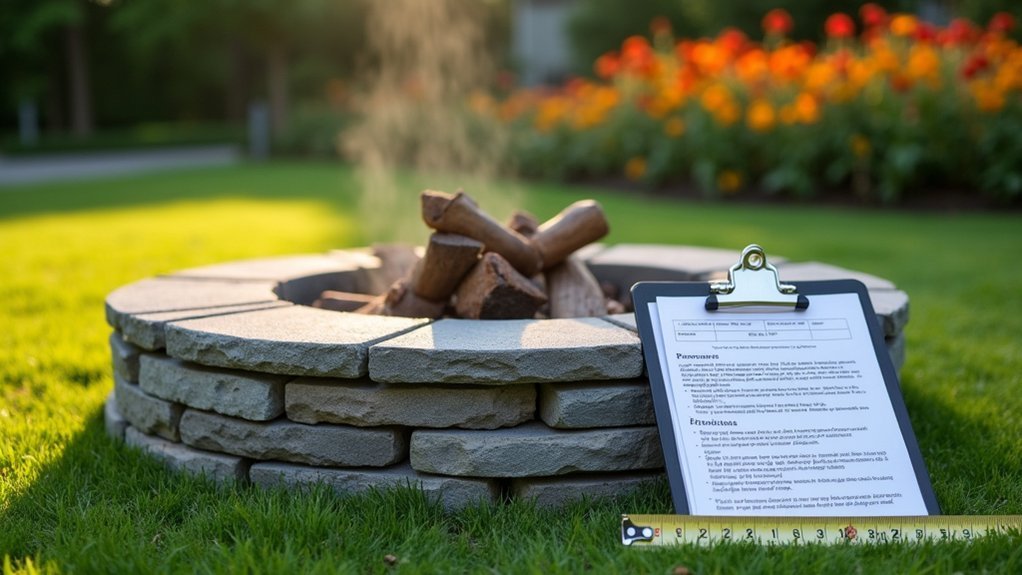
Beyond proper placement, Houston’s fire pit regulations specify exact size and material requirements that’ll determine whether your backyard addition meets legal standards.
Fire pit size regulations mandate a minimum diameter of 36 inches to guarantee safe fire containment. You’ll need to use non-combustible construction materials for fire pits, including stone, brick, or metal – wood and other flammable materials are strictly prohibited under local ordinances.
If you’re planning a permanent installation, you must comply with local building codes that establish specific construction standards and safety measures. Before breaking ground, verify requirements with local authorities or your HOA, as additional restrictions may apply to your specific property or neighborhood.
Fuel Type Restrictions and Approved Burning Materials
While construction materials and size requirements form the foundation of fire pit compliance, fuel type restrictions determine what you can actually burn in your backyard installation. Houston’s regulations vary by neighborhood, so you’ll need to check local ordinances for specific approved burning materials and restrictions.
| Fuel Type | Permitted During Normal Conditions |
|---|---|
| Clean, dry, split firewood | Yes |
| Treated wood/plastics | No |
| Natural gas | Yes |
| Propane | Yes |
| Certain foliage | No |
Gas and propane fire pits typically don’t require additional permits, making them popular choices during burn bans. When dry weather conditions trigger burn bans, all recreational fires become prohibited. You must adhere to fuel type restrictions to avoid legal issues and guarantee community safety.
Mandatory Safety Equipment and Fire Suppression Tools
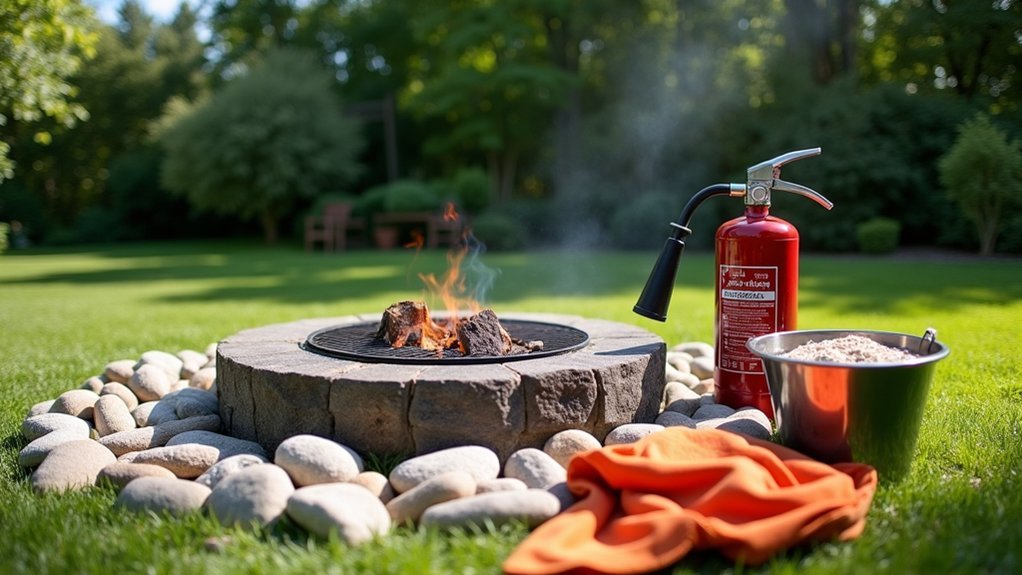
Since fire pits present inherent risks, Houston requires homeowners to maintain specific mandatory safety equipment within immediate reach during operation.
You’ll need a fully charged fire extinguisher positioned nearby for quick emergency response. Additionally, keep a garden hose or water bucket accessible to control unexpected flame spread.
Fire suppression tools aren’t your only requirement. You must install smoke detectors near outdoor living spaces to monitor excess smoke levels, particularly in enclosed areas.
Consider adding a fire blanket to your safety arsenal for smothering small fires or protecting clothing that catches fire.
Regular equipment inspections are essential for compliance. Check your fire extinguisher’s charge level frequently and guarantee all safety tools remain functional.
These requirements align with local fire safety regulations and help protect your property and neighbors from potential fire hazards.
Adult Supervision and Operating Hour Limitations
You’ll need to guarantee an adult supervises your fire pit at all times, as leaving it unattended can result in penalties and safety violations.
Most local ordinances restrict operating hours to specific times of day or night to minimize neighborhood disturbances.
You must also monitor wind conditions closely, since high winds can trigger temporary bans on fire pit use to prevent dangerous fire spread.
Required Adult Supervision
Most local fire pit regulations mandate that a responsible adult must supervise the fire at all times during operation.
Required adult supervision addresses common concerns about fire safety and emergency response capabilities. You’ll find that strict rules exist because adults can quickly extinguish flames if they begin spreading uncontrollably.
Your responsibilities as the supervising adult include:
- Emergency Response – You must remain present to handle unexpected situations like wind changes or spreading embers.
- Regulation Compliance – You’re responsible for ensuring fires are extinguished by designated hours, typically around 10 PM.
- Safety Monitoring – You’ll need to continuously assess conditions and determine when it’s unsafe to continue, especially during high winds.
Check your local ordinances and HOA regulations to understand specific supervision requirements and avoid potential fines.
Operating Hour Restrictions
While adult supervision guarantees fire safety, operating hour restrictions determine when you can legally enjoy your backyard fire pit.
Houston’s operating hour restrictions typically prohibit recreational fires after 10 PM to minimize neighborhood disturbances. However, these hours can vary markedly based on your specific neighborhood or HOA regulations, so you need to take into account checking with local authorities for precise limitations in your area.
Even though fire pits legal in Houston require proper supervision, violating operating hour restrictions can result in considerable penalties, including fines and potential legal action.
Don’t assume standard city hours apply to your location. Your HOA might impose stricter timeframes than municipal regulations. Always verify your neighborhood’s specific operating hour restrictions before lighting your fire pit to guarantee full compliance with local ordinances.
Wind Condition Monitoring
Wind condition monitoring forms a critical component of fire pit safety that complements adult supervision and operating hour compliance.
You’ll need to assess wind conditions before lighting your fire, as local ordinances in Houston often prohibit fire pit use during high wind situations to prevent sparks from spreading to neighboring properties.
Here’s what you should monitor:
- Wind Speed Assessment – Check that gusts remain below 10 mph before starting your fire.
- Direction Evaluation – Verify wind won’t blow sparks toward structures or dry vegetation.
- Ongoing Monitoring – Continuously watch conditions throughout your fire pit session.
Ignoring wind condition regulations can result in penalties and create serious fire hazards.
You’re responsible for staying informed about local guidelines and extinguishing your fire immediately when conditions become unsafe.
Weather Condition Restrictions and Burn Ban Compliance
You must stay informed about active burn bans in your area by regularly checking local news, weather reports, and municipal websites.
Before lighting any fire, you’re required to assess current wind conditions, as many jurisdictions prohibit fires when wind speeds exceed specific thresholds.
Remember that burn bans apply to all recreational fires, including both wood-burning and gas fire pits, until authorities officially lift the restrictions.
Monitoring Active Burn Bans
How can you stay ahead of sudden burn restrictions that might shut down your backyard fire pit without warning? You’ll need to actively monitor Houston’s burn ban status since these restrictions can appear unexpectedly during dry conditions.
Here’s your monitoring strategy:
- Check local government websites and fire department announcements regularly for the latest burn ban updates.
- Follow local news and weather reports that announce active restrictions affecting recreational fires and fire pits.
- Set up alerts from Houston emergency services to receive immediate notifications about new burn bans.
When Burning Fire Pits become restricted, violations result in penalties and fines.
Since Pits Legal in Houston can quickly become prohibited, you’re responsible for staying informed.
Consider switching to propane or electric alternatives during active bans to maintain outdoor enjoyment while ensuring compliance and community safety.
Wind Speed Assessment Rules
Beyond monitoring burn bans, weather conditions play an equally important role in determining when you can safely operate your fire pit. Wind speed assessment becomes critical for fire pit users, as local ordinances typically prohibit use during high wind conditions exceeding 10-15 mph gusts.
| Wind Speed | Status | Action Required |
|---|---|---|
| 0-10 mph | Safe | Monitor continuously |
| 10-15 mph | Caution | Check local regulations |
| 15+ mph | Prohibited | Extinguish immediately |
You must check weather forecasts before lighting fires and fire pits, as bans can be enacted on short notice during dry, windy periods. Continuously monitor wind direction and speed while your fire burns. Ignoring these assessments could result in penalties, fines, or property damage. Always consult your local Houston fire department for specific wind-related restrictions in your neighborhood.
Homeowners Association Approval and Additional Covenants
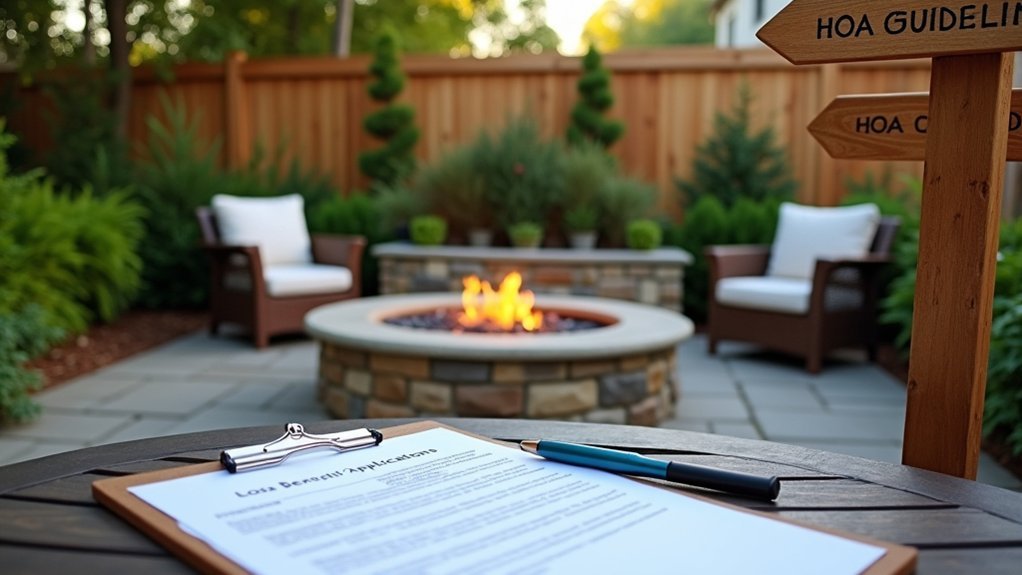
While city permits establish baseline requirements for backyard fire pits, your homeowners association likely maintains its own set of rules that can be more restrictive than municipal ordinances.
These additional covenants can greatly impact your fire feature installation plans.
Before breaking ground, you’ll need to navigate several HOA requirements:
- Pre-installation approval – Submit detailed plans showing your fire pit’s design, size, and exact placement for committee review.
- Fuel type restrictions – Many homeowners associations prohibit wood-burning options, requiring gas or propane alternatives to reduce smoke.
- Safety inspections – Your HOA may mandate post-installation inspections to verify compliance with community standards.
You should thoroughly review your HOA’s guidelines before purchasing materials.
Non-compliance can result in costly fines or mandatory removal of your fire feature.
Fire Department Inspection and Certification Standards
Once you’ve secured HOA approval, your fire pit installation must pass fire department inspection to meet mandatory certification standards.
Houston requires permits for most fire pits, triggering an inspection process that verifies compliance with safety standards and local regulations. Your fire pit must meet ANSI certification standards, ensuring quality and safety for both permanent and temporary installations on private property.
During the fire department inspection, officials examine proper installation, location placement, and adherence to fire safety guidelines.
You should contact your local fire department early to understand specific inspection requirements and area-specific regulations. Non-compliance results in fines or mandatory dismantling of your fire pit.
Don’t risk penalties—ensure your installation meets all certification requirements before lighting your first fire.
Insurance Notification and Liability Coverage Requirements
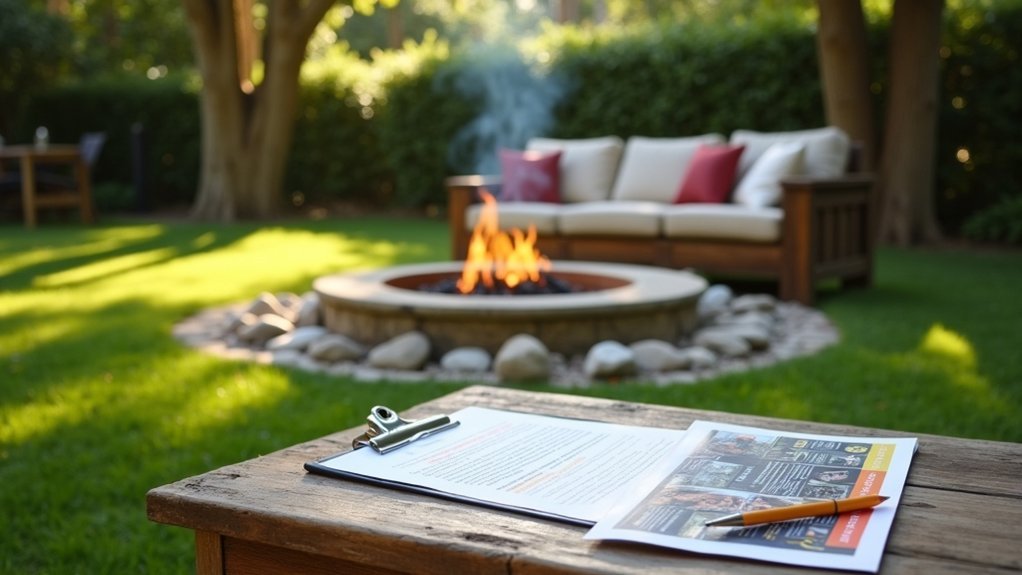
You’ll need to notify your homeowner’s insurance company about your fire pit installation, as failure to disclose this addition could result in denied claims if fire damage occurs.
Your current policy may require additional liability coverage or endorsements to protect against incidents involving recreational fire use.
Contact your insurance provider before installation to understand any premium increases and guarantee you’re adequately covered for fire pit-related liability.
Insurance Disclosure Requirements
Before installing a backyard fire pit, you must contact your homeowner’s insurance provider to disclose the addition and verify your current policy covers fire-related incidents.
Insurance disclosure requirements protect both you and your insurer from potential liabilities.
Your insurance company will likely require documentation proving compliance with local regulations before maintaining full coverage.
Some policies stipulate specific fire pit safety measures to avoid coverage denial during fire-related claims.
To guarantee adequate protection, follow these essential steps:
- Review your policy terms to understand recreational fire coverage limitations
- Obtain required permits and safety inspection documentation
- Submit compliance proof to your insurer within their specified timeframe
Failing to notify your insurance company about your fire pit installation could result in reduced coverage or complete claim denial when you need protection most.
Liability Coverage Essentials
Liability coverage forms the backbone of your fire pit insurance protection, extending beyond basic disclosure to shield you from potential lawsuits and property damage claims.
Your insurance policy should specifically include recreational fire liability to avoid dangerous coverage gaps that could leave you financially exposed. Verify your policy covers fire-related injuries to guests and property damage to neighboring homes, as standard homeowner’s policies may exclude certain fire activities.
Some insurers impose additional safety requirements or coverage restrictions for fire pit owners, particularly in wildfire-prone areas.
Local ordinances often mandate proof of adequate liability coverage before issuing permanent installation permits.
Don’t assume you’re covered—contact your insurance provider to confirm your policy includes thorough fire pit liability protection and meets local regulatory requirements.
Frequently Asked Questions
Can I Have a Fire Pit in My Backyard?
Yes, you can have a fire pit in your backyard in Houston. You’ll need a permit for open fires, but gas/propane pits don’t require permits. Check local ordinances and HOA rules first.
Are Fire Pits Legal in Houston?
Yes, fire pits are legal in Houston, but you’ll need to follow local regulations and get permits for open fires. Gas and propane pits don’t require permits, though HOA rules may apply.
How Far Does a Fire Pit Need to Be Away From a House?
You’ll need to place your fire pit at least 10 feet from your house and 25 feet from trees or shrubs. Check your local ordinances first, since specific distance requirements can vary.
Are Fire Pits Legal in Hawaii?
Yes, fire pits are legal in Hawaii, but you’ll need to check your county’s specific regulations. Most counties require permits for open burning, and burn bans may apply during dry seasons.
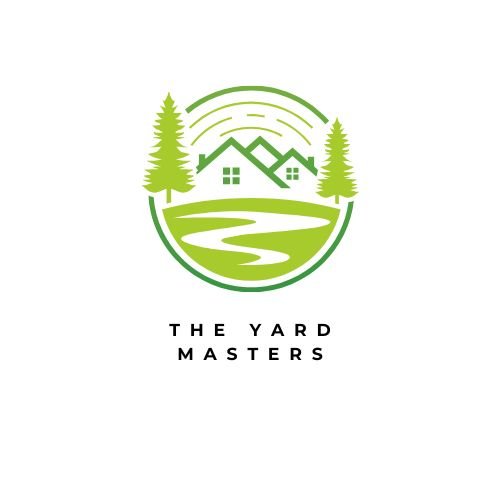
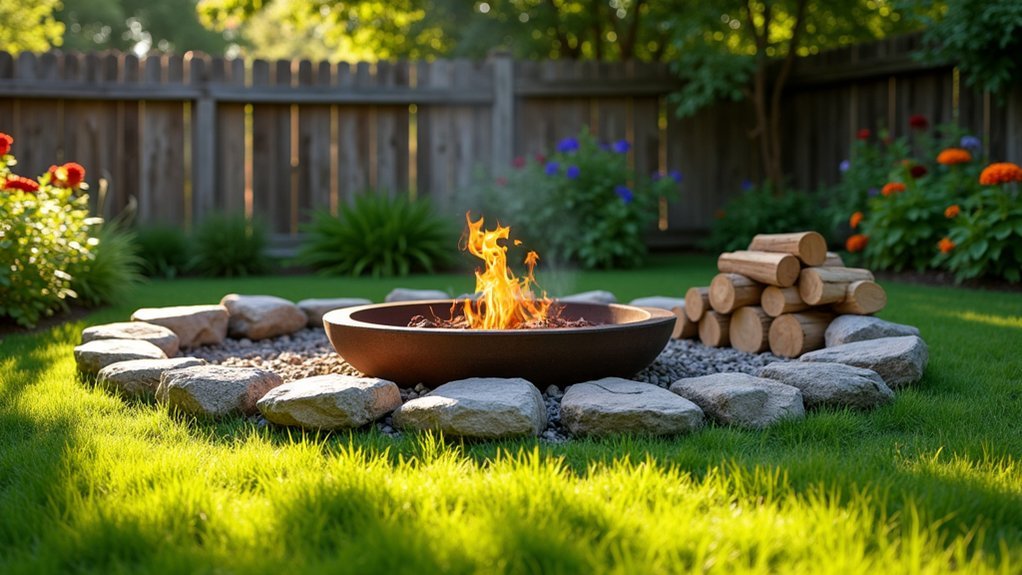



Leave a Reply